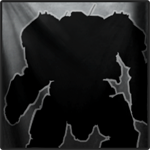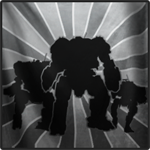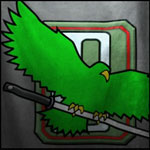BT weapon ranges vs real life weapon ranges?
#1
Posted 29 December 2011 - 09:38 AM
#2
Posted 29 December 2011 - 09:42 AM
You're going to hurt your brain.
#3
Posted 29 December 2011 - 09:42 AM
Applying "realistic", modern ranges would severely change the face of BattleTech warfare and remove what sets it apart from other universes.
#4
Posted 29 December 2011 - 09:45 AM
1 Mech hex = 30m
If you follow ASF ranges, the ERLL has a range of 9.5km.
1 ASF hex = 500m
If you follow CAPITAL ranges, the ERLL has a range of.... well never mind.
1 Capital hex = 18000m
Edited by [EDMW]CSN, 29 December 2011 - 09:48 AM.
#5
Posted 29 December 2011 - 09:50 AM
#6
Posted 29 December 2011 - 09:56 AM
A modern 120mm tank gun can engage (and hit) targets 4000m away, and that's the equivalent power of, say, an AC/10.
The navy is currently testing a railgun that will engage targets from tens to over a hundred miles away.
A machine gun bullet (.50 BMG) can hit man-sized targets 1400m away if fired from a good rifle.
I'm not going into missiles because I'll get hit with an EMP-flare.
Edited by Prosperity Park, 29 December 2011 - 10:05 AM.
#7
Posted 29 December 2011 - 10:21 AM
Edited by MuffinTop, 29 December 2011 - 10:32 AM.
#8
Posted 29 December 2011 - 11:41 AM
#9
Posted 30 December 2011 - 12:38 AM
If they could afford to sit still long enough to work out the elevation angles and had a stationary target, autocannons and such would have the same ranges as Snipers and Long Toms. Though I've worked out BT autocannon shells using a Powley computer before and I have to figure they're firing REALLY heavy shells at low muzzle velocities. Almost more like rapid-fire mortars than modern-day tank guns. Aerospace autocannons likely use much lighter shells with far more propellant and kill with kinetic energy rather than big warheads.
There's also the effect of weapon spread for missiles and autocannon. To put all the shells of an AC burst onto a 'Mech limb means a circular error of no more than about one meter for the whole burst. An AC/20 can put all its shells into a 1m radius circular target at 270m, but at 1km the shells are spreading over an area 16 times larger. Its effectiveness would be more comparable to an LRM-20 at that range. At 5km you'd barely be able to hit anything.
Though, it should be noted that the BTU authors can't care much about physics if the lasers in AeroTech have discrete ranges. A space battle turn is 60 seconds. A laser would be able to hit a target many light-seconds away, which is millions of km. Even one light-second would be way larger than the whole AT2 map.
Edited by CaveMan, 30 December 2011 - 12:43 AM.
#10
Posted 30 December 2011 - 01:27 AM
 CaveMan, on 30 December 2011 - 12:38 AM, said:
CaveMan, on 30 December 2011 - 12:38 AM, said:
I wouldn't be so sure about that. Lasers would suffer diffraction even in vacuum, so they would be unable to inflict damage after some distance, and the ranges of lasers on the BattleTech space map still extend out to dozens or hundreds of kilometers. Also, I'd imagine anything other than large WarShips and JumpShips would be immensely hard to hit beyond several hundred kilometers, especially if it's constantly maneuvering.
Edited by Arctic Fox, 30 December 2011 - 01:28 AM.
#11
Posted 30 December 2011 - 01:59 AM
 Arctic Fox, on 30 December 2011 - 01:27 AM, said:
Arctic Fox, on 30 December 2011 - 01:27 AM, said:
The effects of diffraction in vacuum are tiny for lasers that can have apertures over a meter in diameter. Beams that big stay very well collimated over long distances. The beam would retain its original size for least 20 or 30 thousand km.
And, again, we're talking about mapsheets that are only about 300km across, no more than 1200 if you're using all four sheets in a line. A tenth of a second delay lets a laser hit a target 30,000km away, or about 1700 space hexes. A lowly 1 deg/sec turret tracking rate could cover about 52km/sec at that range, or hit a target moving at a game speed of 173 or so.
#12
Posted 30 December 2011 - 02:14 AM
#13
Posted 30 December 2011 - 03:05 AM
 CaveMan, on 30 December 2011 - 01:59 AM, said:
CaveMan, on 30 December 2011 - 01:59 AM, said:
And, again, we're talking about mapsheets that are only about 300km across, no more than 1200 if you're using all four sheets in a line. A tenth of a second delay lets a laser hit a target 30,000km away, or about 1700 space hexes. A lowly 1 deg/sec turret tracking rate could cover about 52km/sec at that range, or hit a target moving at a game speed of 173 or so.
Hmm. Wouldn't the beam's size increase (mostly) linearly over distance, so that the beam at 300km would have about 16 times the radius at 18km? I might well be wrong, but what I know indicates the increase in distance would render the beam significantly less powerful as the range increases even at these distances.
As for accuracy, you're assuming the tracking system is perfect. Even a slight defect, error or inaccuracy in the mechanism or software will mean that you've completely missed your target at these ranges, especially against tiny targets like ASFs. This is made even worse by the fact that the target will usually be actively maneuvering and accelerating while you're trying to fire.
#14
Posted 30 December 2011 - 02:20 PM
 Arctic Fox, on 30 December 2011 - 03:05 AM, said:
Arctic Fox, on 30 December 2011 - 03:05 AM, said:
Lasers are highly collimated (rays are parallel). Unless you run the beam through a lens to focus it on a specific point, there's not going to be any meaningful variation in the beam width for a thousand km or so. Beyond that the beam takes on a Gaussian distribution, meaning it narrows to a "waist" and then expands over distance.
For a 650nm laser (red) with a 1m aperture, the beam waist is about 6150km from the aperture. About 20 mapsheets, at which point, the beam will actually have twice the intensity of normal (lasers are weird like that). Beyond that point it'll slowly spread out to infinity.
Quote
True, although for a laser, targeting in space is basically just simple trigonometry. Unless they're running the old Pentium 4's with the math defect, it would be shameful for them to make an error at the distances involved. You could work it out on a mechanical adding machine using a slide rule, if you had to.
A 15m long ASF at 30,000km subtends an angle of about 0.1 arc-second, so it would take some real precision to hit. ECM might interfere with the radar targeting enough to make it impossible. WarShips, though, can be up to a hundred times larger, and you could actually eyeball them if you were trained to account for the 0.1s light lag.
#15
Posted 01 January 2012 - 06:20 PM
Of course, if you count the aerotech end of things, mech grad weapons are scary long ranged. I think the vanilla IS small lasers shoot out to around 1.2 or so KM in space combat.
That and there's the extreme and LOS range rules to account for, which allow mechs to pick off targets on the horizon, miles away, with certain of their weapons.
#16
Posted 01 January 2012 - 06:51 PM
As for laser weaponry, we're talking about something that can focus a damaging amount of energy while still withstanding the rigors of pitched combat. Nothing short of a direct hit (aka critical hit) would take them out of commission. I think that faced with this sort of problem, the engineers of the B-Tech world would have opted for function and durability rather than extreme range.
#17
Posted 01 January 2012 - 07:04 PM
#18
Posted 01 January 2012 - 07:55 PM
My favourite pet hate with the BTU is how they totaly nerfed the Machine gun. With current technology a turret mounted .50cal MG with a computer targeting system and using SLAP amunition would have an effective range of 2500m at least. So Imagine how far advanced the MG would be in 3030 after 1000 years of development.
Just to clarify what the main limiting factor involved in the effective range of a .50cal MG, it is not accuracy or loss of kinetic impact but the trace rounds used to aid in targeting. .50cal MG trace rounds usualy burn out at about 1100m which is why it only has an extreme effective range of 1100m. A computerised targeting system would not need trace rounds to hit a target.
I have noticed that some people have a problem with long range sniping in MW, I say that if you have a weapon capable of firing accurately across the map then we should be able to use them if we want to. In MM4/M there were maps that allowed for long range combat as well as maps that were designed for urban close range combat. Some maps were high heat maps and some were low heat which all played a part in your battle planning. If we restrict all the maps to close range combat then the game will become boring very quickly.
#19
Posted 01 January 2012 - 08:17 PM
BT with realistic appearance
I still think realistic physics with BT appearance and touch could be really nice and probably very popular. It would fix many problems and allowing more room for balance of the game.
There lot of stuff which could be more enjoyable such as:
- realistic artillery (long tom, sniper, thumper canon) shooting from cover in parabolic flight curve of the projectile
- realistic dmg model (more segmentation in hitboxes) > allowing more balance between pierce and splash damage (Laser - PPC, AC-LBX etc.).
- energy management
- ranges
etc.
#20
Posted 01 January 2012 - 10:43 PM
 Phatt, on 01 January 2012 - 07:55 PM, said:
Phatt, on 01 January 2012 - 07:55 PM, said:
My favourite pet hate with the BTU is how they totaly nerfed the Machine gun. With current technology a turret mounted .50cal MG with a computer targeting system and using SLAP amunition would have an effective range of 2500m at least. So Imagine how far advanced the MG would be in 3030 after 1000 years of development.
Just to clarify what the main limiting factor involved in the effective range of a .50cal MG, it is not accuracy or loss of kinetic impact but the trace rounds used to aid in targeting. .50cal MG trace rounds usualy burn out at about 1100m which is why it only has an extreme effective range of 1100m. A computerised targeting system would not need trace rounds to hit a target.
I have noticed that some people have a problem with long range sniping in MW, I say that if you have a weapon capable of firing accurately across the map then we should be able to use them if we want to. In MM4/M there were maps that allowed for long range combat as well as maps that were designed for urban close range combat. Some maps were high heat maps and some were low heat which all played a part in your battle planning. If we restrict all the maps to close range combat then the game will become boring very quickly.
If BT machine-guns were as effective as they should be in real life, everyone would be piloting Piranhas and much fun would be had by all.
...
Except the poor fool in an Atlas trying to kill at least one of the little blighters, of course.
As for real-world ranges taking away the fun, eh. Short-range combat would still be viable in some situations, and considering the almost knightly status of mechwarriors, they'd probably be thick enough to ignore the long-range capabilities in favor of short-range duels.
Then again, it would be funny if they suddenly introduced weapons with realistic ranges into Battletech - say, a new development by one faction. Mounted knights, meet English archers. English archers... oh, you guys already killed the knights, I see.
1 user(s) are reading this topic
0 members, 1 guests, 0 anonymous users


























